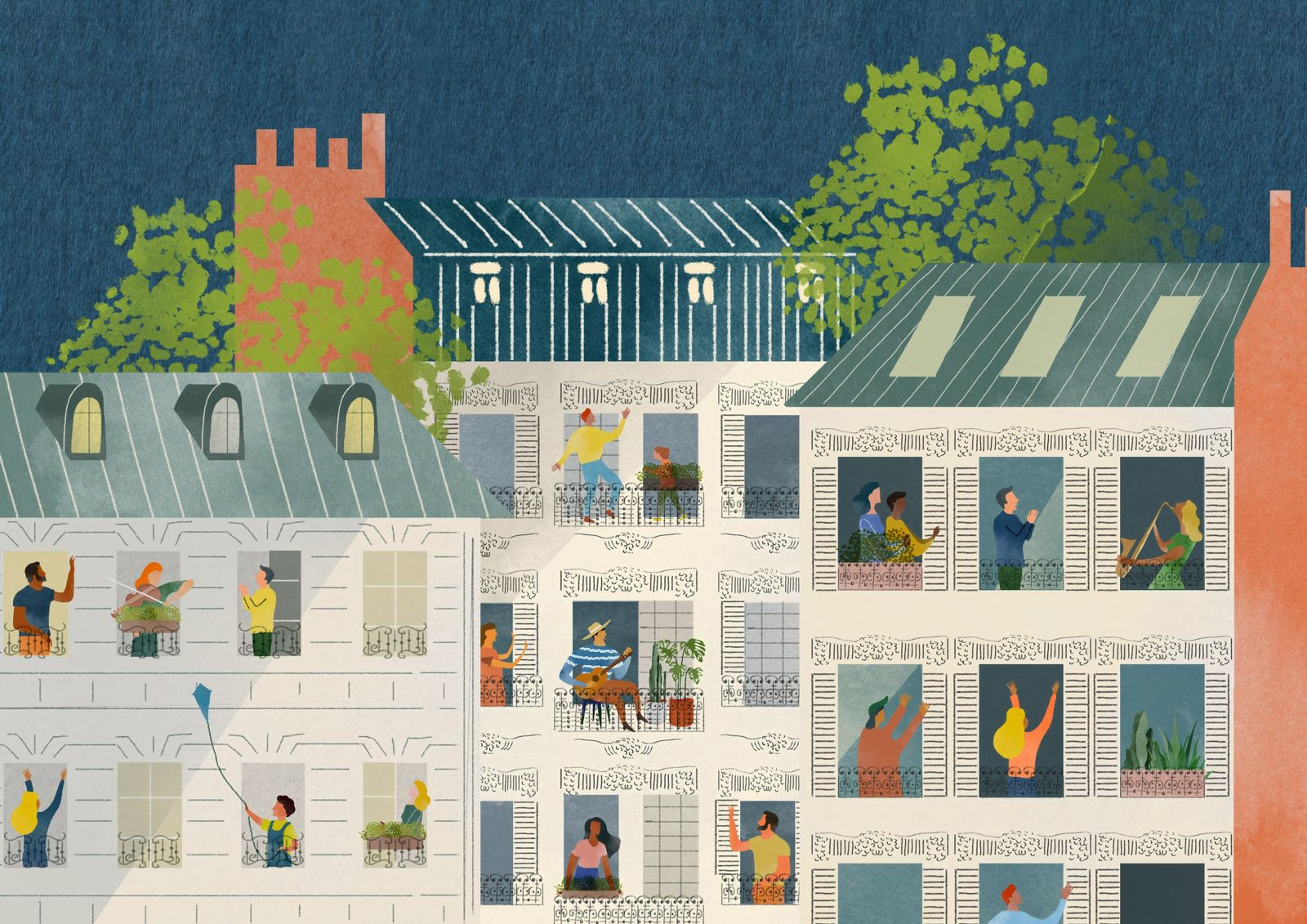Many voices are starting to boldly articulate new visions of how the world could look after the COVID-19 pandemic. But if not tied to an evocative story, the fear, grief, and trauma left behind when this latest crisis recedes may again take us in the wrong direction. To prepare for the better world we can build after it, we have to respond to this moment with determination, courage, and trust, but also with humor, joy, and above all, hope.
Populists thrive in crisis, and the fear, grief, and anxiety caused by this moment could be rocket fuel for authoritarian leaders. How can human rights groups help people to not just see this moment as one of loss and fear, but rather to look back with pride at how we came together to get through this as connected, caring communities?
Human rights actors often focus on reacting to harms and problems, but people also need something to believe in: a vision for how things should be instead and an idea of how to get there. We need to be building that vision and telling that story right now, even as we’re responding to the immediate needs of our communities.
Here are three simple steps human rights groups can use to tell their own story in their response to the pandemic, and to any populist attempts to take advantage of it. This guide draws on and was produced as part of JustLabs’ and the Fund for Global Human Rights’ (FGHR) work with groups around the world developing human rights narratives in response to the populist challenge.
1
Talk about community, not crisis
The story of this moment is still being written—we can still choose to center the heroes, policies, and values that show the resilience of our togetherness.
There are many reasons to see this moment as a crisis, but we know from past financial crashes, natural disasters, and terror attacks that fear infects our public life, discussions, and relations with one another. Crisis feeds populism. Messaging that reinforces crisis can backfire.
A 2019 paper on countering populist narratives, published by JustLabs and FGHR, says the populist narrative thrives through its use of crisis, controversy, and conflict. Like the truism “desperate times call for drastic measures,” a story of crisis helps politicians who want to roll back human rights and grab more power for themselves, something we've already seen in Hungary, Togo, the Philippines and beyond.
“In moments of crisis, new narratives, new policies and new social behaviors are established.”
- Anat Shenker-Osorio, communications expert
The paper proposed a different narrative for human rights groups: one that focuses on cooperation, culture, and community. Whatever happens in the months ahead, people will be left anxious and uncertain. To counter that instinctive fear, the human rights movement must help our societies find that sense of agency and belonging through community and collective action. In doing so it can provide a blueprint for a safer, more caring future.
The challenge

• How do human rights values help people to feel more hope, affirmation, and pride and less anxiety, insecurity, and fear?
• How can rights groups empower people living in lockdown to act on those values?
Our take:
This is a moment of transformation. It could show the failure of populist leaders to improve societies, but it could just as easily become a 9/11 moment that triggers a wave of fear that leads to a backlash against human rights.
This depends largely on how the story of this moment is told: a moment of fear and anxiety where we are confronted with our own vulnerability, or of inspiration and pride at how people joined together to pull through a difficult collective experience.
While anxiety is a dominant emotion in conversations around the pandemic, there is also gratitude at acts of kindness and support, desire for solutions and ways to be involved, and a need for stories full of humor and joy that make light of our collective situation.
 Mortality salience
Mortality salience
Being reminded of death can reinforce people’s existing beliefs in their identity and worldview—a trend known as “mortality salience”. Messages that trigger this anxiety play directly into the hands of charismatic leaders that offer someone to blame for people’s insecurity. Human rights groups need to tell a different story.
Action:
 To avoid the word “crisis”, talk about a moment that we are living through together.
To avoid the word “crisis”, talk about a moment that we are living through together.
The language of war and crisis suggests we need strongmen leaders who use top-down decision-making, whereas economist Amartya Sen has pointed out that a better response would be participatory governance, public discussion, and alert listening by leadership.
Human rights groups can choose instead to use language that helps people remember this moment with pride, as a time when we came together in spite of differences to overcome common challenges. Reminding people that this is a collective experience can set them at ease and reinforce shared humanity. The NGO Liberties recommends talking more in terms of journeys, with human rights as a tool helping us navigate.
Example:
Rutger Bregman has pointed out that while people in Wuhan encouraged each other with the words, “jiayou” (“don’t give up”), in Italy children wrote “andrà tutto bene” (“everything will be all right”) on streets and walls. The “it’s going to be OK” message is part of the antidote to populism, creating calm and togetherness that inoculates societies against the fear that drives the need for scapegoats.
 —What we are reading about psychology—
—What we are reading about psychology—
- Psychologist Alex Evans encourages us to try to trigger tend-and-befriend instincts instead of fight-or-flight and counter loneliness by encouraging agency, belonging, and conscious self-awareness.
- Alice Sachrajda has broken down how we can tell a hopeful, collective story of the COVID-19 moment that ends in building a fairer society.
2
Focus on collective action
This moment shows us just how everybody’s wellbeing is interconnected, and offers a unique opportunity to cultivate compassion and inspire action for economies and societies that prioritize human well-being.
Human rights advocates should focus on showing how we can get through this together, if we act together. This is a moment of collective experience: we are all going through this together. Many of us are under lockdown, but we are alone, together.
The challenge

• How can a human rights worldview help people make sense of what is happening?
• How do human rights groups show how governments should be acting?
Our take:
The role of government is to care for people. That message can get lost in the “name and shame” approach of calling out government failures and abuses. A strategy of casting blame risks falling flat with public audiences stuck in lockdown and desperate for action.
As the Framework Institute warns: “When people see governments as wholly useless or corrupt, it perpetuates inaction and drives disengagement”. It recommends calling on governments to use “the best tools humanity has to rebuild our societies” and helping citizens focus on what specific actions we should expect from leaders and public institutions and agencies.
Human rights groups should think about how human rights values help us to understand what is happening and how to best respond. Rather than feeding a sense of helplessness in the midst of chaos, how can we engage people’s values and point them towards solutions and actions for the common good?
Action:
 Don’t personalize, collectivize. Celebrate moments of community to channel feelings of belonging into sustained collective action.
Don’t personalize, collectivize. Celebrate moments of community to channel feelings of belonging into sustained collective action.
Telling people not to go out to avoid harm is not as effective as asking people to #stayhome to help others, for the common good.
While we want to highlight the plight of the most vulnerable, new messaging guidance from Liberties warns that we should start with shared values that bind all of us, rather than a distinct “them” which “makes the problems they face, their problem, not ours.”
Similarly, criticizing governments—without also setting out an alternative course of action—risks making human rights seem like an obstacle to the Coronavirus response, when it is actually a blueprint. We can highlight the solutions governments should be taking—both immediately and in the long-term—with a focus on their duty to care for people, especially the most vulnerable.
When leaders use this moment to try to limit human rights or grab power for themselves, we need to hold up examples of collective action to show that the best response is to work together, not alone.
Telling stories of care and solidarity today will help mobilize action around these values, pointing us towards better solutions and ensuring we look back on this moment with pride, gratitude and belonging.
Example
People around the world are showing enormous levels of solidarity and togetherness, from singing and cheering from balconies to creatively organizing and mobilizing support for people in situations of vulnerability. From India to Argentina to Honduras, communities are organizing their own community kitchens to combat food insecurity. A grassroots social service provider in Kenya is setting up hand-washing stations to distribute information and hand sanitizer.
Human rights groups can elevate stories like this to make the values they represent more salient in the way we think about—and remember—how our societies (and civil societies!) responded to the pandemic.
 —What we are reading about framing—
—What we are reading about framing—
- Communications experts like Anat Shenker-Osorio point out that this moment highlights our interdependence, while former leaders like Gordon Brown have highlighted the importance of global cooperation.
- Frameworks Institute has issued a series of messaging guides advising how to talk about government responsibility, the common good, and the future.
- Kirsty McNeil has written advice about thinking globally, and Liberties has written on talking about human rights during COVID-19.
3
Start telling a confident story of tomorrow, today
This moment is a reminder that resources for big change can be found when there is political will. Leading thinkers from Arundhati Roy to Yuval Harari have urged us to embrace bold thinking about the post-pandemic future.
Yet even before the outbreak of the pandemic, many of the human rights movement’s traditional strategies and institutions were struggling to rally people the way populists can. Now, as people everywhere are living in lockdown, it is more important than ever to rethink how being part of the human rights movement can empower people to carry out acts of global solidarity and contribute to global change.
This also means articulating with confidence how it feels to live in the rights-respecting society we are working towards.
The challenge:

• How can human rights action empower and give agency to people under lockdown?
• How does a rights-based approach explain the decisions that allowed the pandemic to happen? How can it help us look forward to a world where we are better prepared to get through an event like this?
Our take:
This moment can trigger long-overdue transformational human rights innovation. We can start by trying to articulate what the world we are trying to build looks like, and what actions today already show what that change looks like.
“A pandemic reveals how utterly human we all actually are. As a community devoted to change, our role is to meet people in that place of humanity, listen to them, and show them that there are other ways to see our world.”
As the Be the Narrative paper from JustLabs and FGHR said, our actions should reflect the narrative, as well as the actual change, that we want to see in the world. That paper ended with a call to “Put the human in human rights”.
Human rights groups should be talking about human rights as something we can all do, rather than something governments take away from us. If human rights is a tool, how can people stuck in lockdown find agency by using that tool to start taking steps towards those bold new visions?
Action:
 Reframe the criticisms you have today as aspirations to achieve together going forward. Try completing the sentence: “In the future…”:
Reframe the criticisms you have today as aspirations to achieve together going forward. Try completing the sentence: “In the future…”:
-
In the future, by putting solidarity and strength in togetherness at the core of our systems, our leaders can rebuild what we now lack—the collective ability to keep society healthy, figuratively and literally.
-
In the future, more caring, kind societies can make us better prepared for pandemics, fake news, cybercrime, climate change, and the complex, global, and unprecedented challenges that may arise.
This messaging will start building support for future changes now, building a human rights worldview based on the importance of care and treating each other well. Instead of accepting the false assumption that a society’s strength comes from military might and strong borders, we can show how solidarity helps us all: more homes, more hospitals, more schools.
Try to find stories happening now that illustrate these messages and reflect how the tools, technologies, and mindsets becoming necessary are already emerging through local and global networks of collaboration and support. Now more than ever is the time to be plugged into these networks and elevate grassroots voices, different ideas of power and visions of alternative futures.
Example:
Constantly promote the value of care. Celebrate leaders who demonstrate the effectiveness of a pandemic response built on care and empathy, like New Zealand’s prime minister Jacinta Ardern. Seek out stories, like this image of a military plane repurposed to care for the sick, that show a new vision for what a strong, safe society looks like—one based on the ability to care for each other.
To help bring these messages to life, we—as organizations, activists, practitioners, and funders—need to explore new ways of connecting to our communities and to one another. Responses like the Free the Vaccine for COVID-19 project provide inspiration for new thinking about what civil society can look like: they are anticipating future challenges and adapting their organizational model to our current reality, leveraging the collective energy of the moment through new platforms to start globally building local solutions.
 —What we are reading to imagine different futures.—
—What we are reading to imagine different futures.—
- Arundhati Roy has highlighted the pandemic as a “portal to another world”.
- Yuval Harari has written that the crisis can help humanity decide to choose the “path of global solidarity”.
- Kathryn Sikkink and César Rodríguez-Garavito discuss forward-looking, hope-based human rights responses to the pandemic.
- Gordon Brown highlighted how the pandemic is a failure of global leadership.
- Alex Evans points out that moments of crisis often lead to a reshaping of the world order.
Now share your thoughts and stories
Do you have an example of how you or your organization is using hope and innovation to respond to the pandemic? Questions about the challenges you’re facing or the framing of a message?
Tweet us @team_justlabs and @hopebasedcomms.


